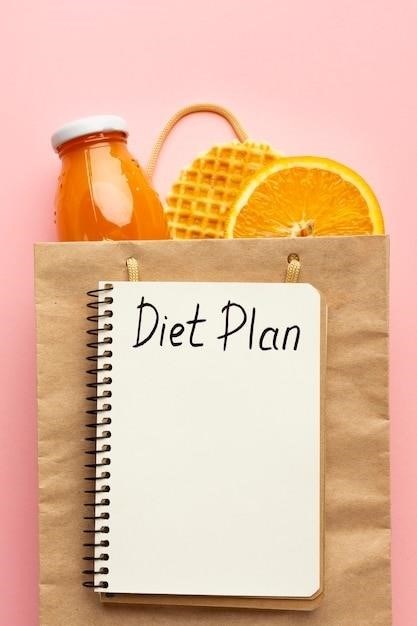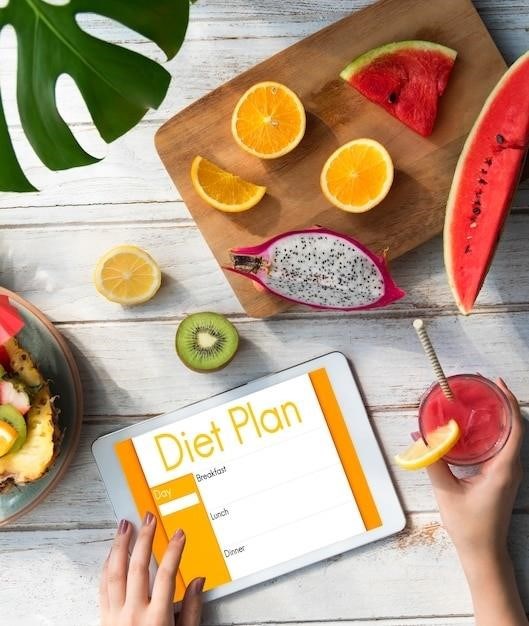Noom Diet Plan⁚ Free PDF and Everything You Need to Know
Are you looking for a weight loss program that’s more than just counting calories? Noom is a popular app-based program that uses behavioral psychology to help you change your eating habits and lose weight. With its color-coded food system, personalized coaching, and supportive community, Noom aims to help you build sustainable habits that last a lifetime. We’ll explore what makes Noom different, what you can eat on the Noom diet, and how to get a free Noom diet plan PDF.
What is the Noom Diet?
The Noom diet isn’t a rigid diet plan with strict rules or forbidden foods. Instead, it’s a comprehensive weight loss program that focuses on changing your relationship with food through behavioral psychology. Noom emphasizes understanding why you eat what you eat and how to make sustainable changes to your eating habits.
The core of the Noom diet is its color-coded food system, which categorizes foods into three groups⁚ Green, Yellow, and Red. Green foods, such as fruits, vegetables, and whole grains, are the least calorie-dense and encouraged to be the foundation of your diet. Yellow foods, including fish, chicken, meat, and milk, are more calorie-dense and should be enjoyed in moderation. Red foods, which include sweet or fried foods and snacks, are the most calorie-dense and are limited to occasional indulgences.
Noom aims to empower you to make informed choices about your food without feeling restricted. The app provides daily lessons, interactive activities, and a support group to help you stay motivated and learn about healthy eating habits. You’ll also have access to a personal coach who can offer personalized guidance and support.
How Does Noom Weight Work?
Noom’s approach to weight loss goes beyond simply telling you what to eat; It focuses on understanding the underlying reasons behind your eating habits and helping you develop healthier behaviors. Noom’s program utilizes a combination of behavioral psychology, personalized coaching, and a supportive community to guide you towards sustainable weight loss.
The core of the Noom program is its daily lessons and interactive activities, designed to help you understand the science of behavior change and how to apply it to your eating habits. These lessons cover topics such as mindful eating, emotional eating, and how to overcome cravings. You’ll also learn about the relationship between food and your emotions, helping you identify and address the triggers that lead to unhealthy eating choices.
Noom encourages you to track your food intake using its app, which allows you to log your meals, snacks, and even your physical activity. This feature helps you become more aware of your eating patterns and how your food choices affect your overall calorie intake. However, Noom doesn’t emphasize strict calorie counting, instead focusing on creating a balanced diet that satisfies your nutritional needs and promotes healthy weight loss.
What Makes Noom Weight Different?
Noom distinguishes itself from other weight loss programs by incorporating behavioral psychology into its approach. Rather than simply providing a diet plan, Noom focuses on understanding the reasons behind your eating habits and helping you develop healthier behaviors. This personalized approach, coupled with its user-friendly app and supportive community, makes Noom stand out as a comprehensive program designed for long-term success.
One of Noom’s key differentiators is its color-coded food system. This system categorizes foods into green, yellow, and red categories based on their calorie density and nutritional value. Green foods, such as fruits, vegetables, and whole grains, are the least calorie-dense and encouraged for regular consumption. Yellow foods, including lean proteins and dairy, are more calorie-dense but still considered healthy options. Red foods, like sugary treats and processed snacks, are the most calorie-dense and recommended to be consumed in moderation. This simple yet effective system helps users make informed choices about their food intake and develop a balanced diet.
Noom also emphasizes personalized coaching and community support. You’ll be paired with a certified Noom coach who provides weekly check-ins and guidance, offering encouragement and answering your questions along the way. The app also features a supportive community where you can connect with others on their own weight loss journeys, sharing experiences, tips, and motivation. This sense of community fosters accountability and helps you stay motivated on your path to achieving your health goals.
What Can You Eat on Noom?
Noom doesn’t restrict you from eating any specific foods, but it does encourage you to make mindful choices based on its color-coded food system. This system categorizes foods into green, yellow, and red categories based on their calorie density and nutritional value. Green foods, such as fruits, vegetables, and whole grains, are encouraged for regular consumption as they are the least calorie-dense and rich in nutrients. Yellow foods, like lean proteins, dairy, and some whole grains, are considered healthy options but are more calorie-dense than green foods. Red foods, including sugary treats, processed snacks, and fried foods, are the most calorie-dense and are recommended to be consumed in moderation.
Noom emphasizes a balanced diet that includes a variety of foods from all categories. You can enjoy your favorite foods, but Noom helps you make conscious decisions about portion sizes and frequency. By prioritizing green and yellow foods, you can create a healthy and satisfying eating pattern that supports your weight loss goals.
Noom provides a comprehensive food list with specific examples within each category. This list helps you understand which foods are considered green, yellow, or red, making it easier to make informed choices when grocery shopping and meal planning. You can find examples of green foods like apples, bananas, blueberries, broccoli, and whole-grain bread. Yellow foods include chicken, fish, milk, and some types of cheese. Red foods include candy, cookies, chips, and fast food. Noom’s color-coded system encourages you to eat a variety of foods, with an emphasis on whole, unprocessed foods, and to make conscious choices about portion sizes and frequency.
Noom Sample Menu
Noom’s meal plans are personalized to your individual needs and preferences. However, you can get a general idea of what a Noom diet might look like through sample menus. Here’s an example of a daily meal plan that incorporates the color-coded system⁚
- Breakfast⁚ 340 calories. Omelet with 2 scrambled eggs, 1/2 cup roasted butternut squash, and a side of sautéed spinach.
- Lunch⁚ 450 calories. Salad with 4 oz grilled chicken breast, mixed greens, cherry tomatoes, cucumber, and a light vinaigrette.
- Dinner⁚ 300 calories. Baked salmon with roasted asparagus and a small portion of brown rice.
- Snack⁚ 100 calories. A handful of almonds or a small piece of fruit like an apple or banana.
This sample menu provides a balance of protein, carbohydrates, and healthy fats. The omelet for breakfast offers a good source of protein, while the butternut squash and spinach provide essential nutrients. The salad for lunch is a light and refreshing option with lean protein from the chicken breast and plenty of fiber from the vegetables. The baked salmon for dinner offers a good source of omega-3 fatty acids, and the roasted asparagus and brown rice provide complex carbohydrates and fiber. The snack of almonds or fruit helps to keep you feeling full and satisfied between meals.

Keep in mind that this is just a sample menu, and your personalized Noom meal plan will be tailored to your individual needs and preferences. Noom offers a variety of recipes and meal ideas to help you stay on track and make healthy choices. Remember that flexibility is key. You can adjust the sample menu to fit your tastes and dietary restrictions while maintaining the principles of Noom’s color-coded system.
How Much Does Noom Cost?
Noom offers a subscription-based model for its weight loss program. The cost of Noom varies depending on the length of your subscription. While a free trial is available, it’s important to note that it’s limited in duration and features. Noom’s pricing structure is designed to incentivize long-term commitment to the program.
Here’s a breakdown of Noom’s subscription costs as of October 2024⁚
- One-Month Subscription⁚ This option provides access to Noom’s features for a shorter duration. It’s a good choice for those who want to try out the program before committing to a longer subscription. The cost for a one-month subscription is typically around $59.
- Three-Month Subscription⁚ This option offers a more affordable price per month compared to the one-month subscription. It’s a good option for those who are serious about their weight loss goals and want to commit to a longer period of time. The cost for a three-month subscription is typically around $149, which translates to approximately $49.67 per month.
- Six-Month Subscription⁚ This option provides the most significant cost savings per month. It’s ideal for individuals who are determined to reach their weight loss goals and want to benefit from the long-term support and guidance Noom offers. The cost for a six-month subscription is typically around $269, which works out to approximately $44.83 per month.
Noom also offers discounts and promotions from time to time, so it’s worth checking their website for any current deals. Remember that the cost of Noom can be considered an investment in your health and well-being. It provides a structured program, personalized guidance, and a supportive community to help you achieve your weight loss goals and maintain a healthy lifestyle.
Is There a Free Version of Noom?
While Noom doesn’t offer a completely free version of its weight loss program, it does provide a limited-time free trial to give potential users a taste of what the app has to offer. This free trial allows you to explore Noom’s features, including its daily lessons, food logging, and community support, for a short period. However, it’s crucial to understand that the free trial is not a substitute for a full subscription and has certain limitations.
The free trial typically lasts for a week or two, during which you can access most of Noom’s core features. However, some features may be restricted or limited during this trial period. Additionally, the free trial is designed to provide a glimpse into Noom’s approach and functionalities, but it’s not a complete representation of the full program. It doesn’t include access to all of Noom’s advanced features or the full support of a personalized coach.
After the free trial ends, you’ll need to subscribe to continue using Noom; If you decide to subscribe after the trial, you can choose from different subscription plans based on your budget and commitment level. Noom’s paid subscriptions provide full access to all of its features, including personalized coaching, unlimited food logging, and a supportive community.
In conclusion, while Noom doesn’t offer a completely free version, the free trial allows you to experience its features before making a commitment. It’s a great way to see if Noom’s approach aligns with your weight loss goals and preferences before investing in a paid subscription.
Free Noom Diet Plan PDF Download
While Noom itself doesn’t offer a downloadable PDF version of its official diet plan, there are numerous resources online that provide free Noom-inspired meal plans and guides. These resources often draw inspiration from Noom’s color-coded food system and its emphasis on healthy, balanced eating.
You can find a variety of free Noom diet plan PDFs by searching online using keywords like “Noom diet plan PDF free download,” “Noom meal plan printable,” or “Noom food list.” Many websites and blogs dedicated to health and nutrition offer free downloadable meal plans that align with Noom’s principles.
These free PDFs typically include sample menus for breakfast, lunch, dinner, and snacks, often categorized based on Noom’s color-coded system (green, yellow, and red). They may also provide recipes and tips for incorporating Noom’s approach into your daily meals. However, it’s important to note that these free PDFs are not official Noom resources and may not fully represent the program’s specific guidelines.
If you’re looking for a more comprehensive and personalized experience, consider trying Noom’s free trial. This will give you access to the app’s full features and coaching support, allowing you to create a tailored plan that meets your individual needs. Remember, a free PDF can offer inspiration, but Noom’s app provides a truly customized and supportive approach to weight loss.
Noom App and Meal Planning Features
The Noom app is the heart of the program, offering a comprehensive platform for meal planning, tracking, and support. Its key features include⁚
- Color-Coded Food System⁚ Noom categorizes foods into green, yellow, and red based on their calorie density and nutritional value. Green foods are the most nutrient-dense and calorie-light, while red foods are typically more calorie-rich and less nutritious. This system encourages you to make informed choices about what you eat.
- Personalized Meal Plans⁚ Noom doesn’t provide pre-set meal plans; instead, it uses your individual goals, preferences, and lifestyle to create a personalized plan. You can adjust your calorie intake, macro targets, and even specific food preferences to ensure the plan aligns with your needs.
- Recipe Recommendations⁚ The app provides a library of recipes that align with your goals and preferences. You can search for recipes based on specific ingredients, dietary needs, or meal type.
- Food Logging and Tracking⁚ Noom encourages you to log your meals, snacks, and even exercise. This helps you stay accountable and understand your eating patterns. The app allows you to easily track calories, macros, and other nutritional information.
- Calorie Counting⁚ Noom focuses on calorie counting as a tool for understanding your intake, but it’s not the only focus. The app also emphasizes mindful eating and making healthier choices overall.
- Interactive Lessons⁚ Noom incorporates daily lessons that teach you about nutrition, behavior change, and mindful eating. These lessons are designed to help you develop a deeper understanding of your eating habits and how to make sustainable changes.
The Noom app’s features empower you to take control of your eating habits and make informed decisions about your diet. While free Noom diet plans are available online, the app provides a more personalized and interactive approach to weight loss.
Noom’s Approach to Clean Eating
Noom’s approach to clean eating emphasizes whole, unprocessed foods, and it integrates seamlessly with its color-coded food system. While it doesn’t prescribe a strict “clean eating” diet, it encourages you to prioritize nutrient-dense options that are naturally good for you.
- Focus on Whole Foods⁚ Noom promotes a diet rich in fruits, vegetables, whole grains, lean proteins, and healthy fats. These foods are naturally nutrient-rich, providing your body with essential vitamins, minerals, and fiber. They are also lower in calories and more filling than processed foods, making it easier to manage your weight.
- Limit Processed Foods⁚ Noom discourages excessive consumption of processed foods, which are often high in calories, added sugars, unhealthy fats, and sodium. While it doesn’t completely eliminate them, it encourages you to be mindful of their intake and prioritize whole foods as the foundation of your diet.
- Moderation and Flexibility⁚ Noom encourages a balanced approach to eating, emphasizing moderation and flexibility. It’s not about eliminating entire food groups but rather making healthier choices most of the time. You can still enjoy your favorite foods, but within a framework of overall healthy eating.
- Personalized Guidance⁚ Noom’s color-coded system and personalized meal plans help you navigate the clean eating approach. The app provides guidance on making healthier choices within your specific dietary needs and preferences.
Noom’s approach to clean eating is a practical, sustainable, and enjoyable way to nourish your body and achieve your health goals. By focusing on whole foods, limiting processed foods, and embracing moderation, you can create a balanced and fulfilling diet that supports your overall well-being.
Noom’s 3-Day Clean Eating Meal Plan Example
Here’s a sample 3-day clean eating meal plan that incorporates Noom’s principles. Remember, this is just an example, and you can tailor it to your preferences and dietary needs. It emphasizes whole foods, moderate portions, and healthy choices.
Day 1⁚
- Breakfast⁚ Oatmeal with berries and a handful of almonds.
- Lunch⁚ Salad with grilled chicken, mixed greens, avocado, and a light vinaigrette.
- Dinner⁚ Salmon baked with roasted vegetables (broccoli, carrots, bell peppers).
- Snacks⁚ A piece of fruit (apple, banana), a handful of nuts, or a small yogurt.
Day 2⁚
- Breakfast⁚ Scrambled eggs with whole-wheat toast and spinach.
- Lunch⁚ Leftover salmon with a side of brown rice and steamed vegetables.
- Dinner⁚ Lentil soup with whole-wheat bread.
- Snacks⁚ A cup of mixed berries or a small handful of trail mix.
Day 3⁚
- Breakfast⁚ Greek yogurt with granola and fruit.
- Lunch⁚ Turkey wrap on whole-wheat tortilla with lettuce, tomato, and avocado.
- Dinner⁚ Chicken stir-fry with brown rice and mixed vegetables.
- Snacks⁚ A small handful of dried fruit or a few squares of dark chocolate.
This plan incorporates a balance of protein, carbohydrates, and healthy fats, ensuring you feel full and satisfied throughout the day. You can adjust the portions and specific foods to your liking, making sure to prioritize whole, unprocessed options.


Leave a Reply
You must be logged in to post a comment.